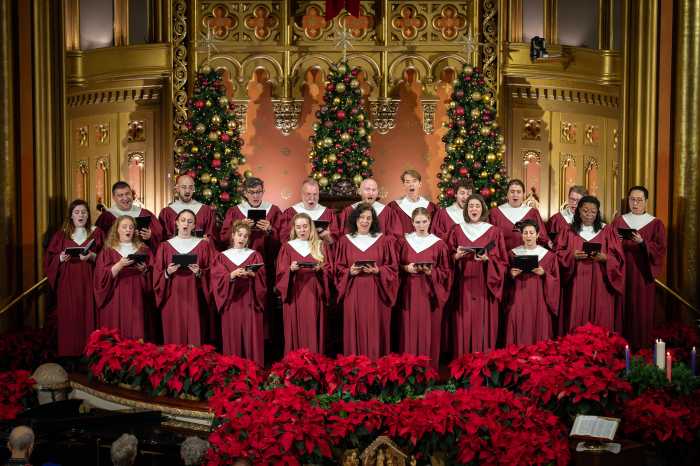The elimination of traditional blackface from Bartlett Sher’s new Metropolitan Opera production of Verdi’s “Otello” has occasioned considerable controversy online and in the print press. Both the Shakespeare play and Arrigo Boito’s libretto for Verdi’s opera refer to the Moor of Venice as “black.” By the Renaissance, “moor” (often “blackamoor”) referred to sub-Saharan Africans. The Moorish people are Muslim North Africans who migrated to Spain and Southern Europe, and their skin tone varies widely — many resemble Southern European Caucasians. All the Shakespearean Othellos I have seen have been played by black actors (though white stage Othellos from Tommaso Salvini to Laurence Olivier have portrayed the Moor as a black man); but all of my operatic Otellos have been Caucasian singers in black makeup.
What is crucial is that Othello/ Otello be “other” — a social outsider by reason of either race, ethnicity, or religion. It is one of the factors in Iago’s malevolent hatred, the opposition to his marriage to Desdemona, and the insecurity that causes Othello to so quickly believe she is betraying him with a younger white man. Visually, black skin is a powerful metaphor for “other” in an otherwise all-white cast (though an Arabic Muslim Othello/ Otello would resonate in our post 9/11 world). In Sher’s production, the lack of any indication of Otello’s “other” status didn’t register as a telling theatrical choice but rather just one more dramatic element that fell by the wayside amidst a barrage of pointless high tech sturm und drang scenic effects.
The period has been updated to the late 19th century — contemporary with the opera’s composition. There’s nothing objectionable there. The production color scheme is limited to black, grayish blue, and silver, with the only flashes of color provided by Catherine Zuber’s costumes (Desdemona’s red ball gown in Act III underlining her alleged “scarlet woman” status). The scenery (designed by Es Devlin) and video projections (from Luke Halls) are constantly in movement while the soloists and chorus often simply stand downstage in serried rows or scattered clumps.
A musical success is undercut by unaccountable dramatic choices
The opening storm scene looks like an oratorio performed in front of a computer screen saver. Two stationary walls upstage serve as projection screens with doors that open up to admit 20-foot moving architectural façade set pieces constructed from Lucite. These translucent moving walls with inner stairs and arched doorways were reconfigured to create at least four different settings in Act II alone. Props and stage furniture were mostly absent, except for Act IV where Desdemona’s bedchamber consisted of a French provincial bedroom set marooned in a cloud and sea-swept void. Donald Holder’s chiaroscuro lighting scheme favors brightly spotlighted soloists emerging from the dark shadows looming in the background. (However, the downstage strobe flashes that erupted at Otello’s Act I “Esultate!” entrance need to be rethought before the HD filming. Otello is not a Las Vegas magician, and he is not Madonna playing Madison Square Garden.)
Though the libretto clearly indicates that Acts II and III take place during daytime in sunny Cyprus, the entire action unfolds in an eternal dark and stormy night under threatening gray-blue storm clouds. which briefly changed to pre-dawn gold mid-scene arbitrarily.
All this visual overkill left the director and his cast almost literally in the dark and at sea. Nothing onstage creates a credible theatrical environment; any human action that constitutes drama gets lost in the shuffle. Sher contributes stage blocking of a dully basic and unimaginative sort but little actual direction of the principals and no discernable production concept. On opening night, the male leads reportedly were not at their best — Sonya Yoncheva’s radiant voice and presence as Desdemona shone like a light in the darkness. At the second performance on September 24, the talented principal singers abetted by a brilliant conductor, Yannick Nézet-Séguin, asserted their strong vocal and dramatic personalities to counteract Sher’s inert production.
Aleksandrs Antonenko’s ringing metal gong of a tenor has the basic vocal materials for an imposing Otello, but somehow the pieces didn’t come together. In the first two acts, the Latvian tenor’s squeezed Slavic voice production distorted vowels, line, and occasionally pitch. At less than full tilt, his sound was inexpressive, lacking softer colors and warmth. His interpretation seemed alternately stolid or distracted. Antonenko’s broad features lack mobility and can look either brutish or impassive.
After intermission, Antonenko’s acting and singing became more focused and engaged. A burnished bronze tone color emerged. As the Moor is consumed by jealousy and paranoiac rage in the final acts, he seemed physically and temperamentally energized, culminating in a powerful death scene. But, an element of nobility is missing — another director might have given him acting business that would deepen his characterization.
As the master manipulator Iago, Željko LuÄić’s stage demeanor tends toward the introverted and recessive — his manner was enigmatic and impassive. In the Shakespeare play, a quiet enigmatic Iago seems a valid concept. In Verdi’s opera, a more proactive, even melodramatic villain is crucial to provide dramatic focus and drive the narrative (especially with an Otello who needs dramatic prodding). LuÄić’s burly baritone commanded his music — his cool, grainy timbre is distinctive and expressive if unitalianate.
In her role debut, Yoncheva’s Desdemona was the most completely realized performance of the evening. She maintained an elegant vocal line with sculpted legato. Yoncheva’s cool lyric soprano has a dark core that fulfills the role’s spinto requirements, with enough cut and projection to soar over the ensembles. Her shimmering silvery timbre was on display in Act IV’s “Willow Song” and “Ave Maria,” culminating in a perfectly floated pianissimo A flat. Yoncheva’s fragile but sensual stage presence made Otello’s suspicions almost credible.
The supporting roles made less impression.
Nézet-Séguin’s tempos were fleet but never forced, details were savored and he relaxed when his soloists needed repose or expansion. Due to his efforts and the improving vocalism of his cast, this was a musically memorable “Otello.” Dramatically however, this production is not likely to improve over this run or in future seasons.
The autumn 2015 revival of Verdi’s “Il Trovatore” gives New York audiences their first glimpse of Anna Netrebko’s passionate rebel Leonora and the return of Dmitri Hvorostovsky, who is appearing as Di Luna in the first three performances (including the HD) in between radiation treatments for brain tumors. Unlike the usual stand-and-deliver aristocratic heroine, Netrebko’s Leonora is a vital, flesh and blood woman so totally consumed by her passion for the troubadour Manrico that she throws aside her family, society, religious beliefs, and eventually her own life for his sake. This perfectly matches Netrebko’s reckless, sensual, exuberant stage temperament and Verdi’s over-the-top Romanticism.
Her ripe, dusky soprano sounded on this occasion a touch heavy and at times sluggish. She eschewed the D flats and C’s other sopranos have interpolated into the role, and one written high C in “Tacea la Notte” was unsettled. Netrebko will likely improve on this as the run progresses.
In Act IV, Netrebko rose to greater heights, floating “D’amor sull’ali rosee” in an ethereal piano tone decorated with delicate trills. She then dug into a juicy chest voice for the “Miserere,” attacked the scales of “Tu vedrai” with fearless abandon, and faced off with Hvorostovsky in a sizzling duet.
Hvorostovsky received a huge ovation on his entrance as Di Luna –– so intense that the action stopped and he smilingly placed his hand on his heart in acknowledgment. Happily, his baritone is in fine estate ––free of the husky tone, labored breathing, and woofy high notes that plagued his Renato in “Ballo” last season. He sounded rested singing with velvety legato. The ovation after “Il Balen” lasted even longer. At the final curtain call, Hvorostovsky was pushed forward for a final solo bow and pelted with white roses by cast and orchestra
Another familiar face from this production’s premiere, the 63-year-old Dolora Zajick at first sounded like the veteran she is. “Stride la Vampa” was plagued by a hole in the middle range and some cautious attacks on high notes. By the end of the second act, Zajick was operating on all cylinders, with blazing soprano-like high notes and ferocious chest. Her gypsy remains mettlesome.
Yonghoon Lee’s Manrico lacked the vocal star quality of the other three members of the quartet. His timbre is somewhat opaque with a manufactured dark color, but he is a musical and resourceful singer. The phrasing in “Ah si ben mio” was elegant, and he attacked “Di Quella Pira” without fear. Lee also cuts a romantic figure onstage.
Stefan Kocan as Ferrando surprised with a steadier, richer more focused tone –– one hopes he will continue to improve his vocal technique.
Marco Armiliato indulged his star singers a bit too much at the expense of musical momentum and needed greater control in ensembles. His conducting was vivacious with Italianate brio.
David McVicar’s Goya-inspired production manages to create a war-torn landscape of violence and extreme behavior where the outrageous plot turns of this opera seem rational and probable.
“Il Trovatore” will be broadcast to movie theaters in HD on October 3 at 12:55 p.m., and “Otello” will be transmitted on October 17 at 12:55 p.m.


















